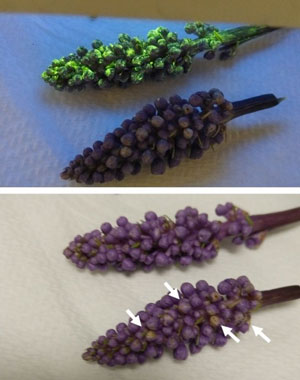| Apr 03, 2019 | |
Nanomaterials give plants 'super' abilities (w/video)(Nanowerk News) Science-fiction writers have long envisioned human–machine hybrids that wield extraordinary powers. However, “super plants” with integrated nanomaterials may be much closer to reality than cyborgs. Today, scientists report the development of plants that can make nanomaterials called metal-organic frameworks (MOFs) and the application of MOFs as coatings on plants. The augmented plants could potentially perform useful new functions, such as sensing chemicals or harvesting light more efficiently. |
|
| The researchers will present their results today at the American Chemical Society (ACS) Spring 2019 National Meeting & Exposition. | |
| According to the project’s lead researcher, Joseph Richardson, Ph.D., humans have been introducing foreign materials to plants for thousands of years. “One example of this is flower dyeing,” he says. “You’d immerse a cut flower stem into some dye, and the dye would be taken up through the stem and penetrate into the flower petals, and then you’d see these beautiful colors.” | |
| Because of their extensive vascular networks, plants readily absorb water and molecules dissolved in fluids. However, it’s more difficult for larger materials and nanoparticles such as MOFs to penetrate roots. So Richardson and colleagues at the University of Melbourne (Australia) wondered if they could feed plants MOF precursors, which the plants would absorb and then convert into finished nanomaterials. | |
| MOFs –– which consist of metal ions or clusters linked to organic molecules –– form highly porous crystals that can sop up, store and release other molecules, much like a sponge. Chemists have made thousands of different MOFs so far, with potential applications ranging from storing hydrogen fuel to absorbing greenhouse gases to delivering medications within the body. Having plants make small amounts of these useful compounds in their own tissues could give them new abilities not seen in nature. | |
| To see whether plants could make MOFs, Richardson and colleagues added metal salts and organic linkers to water and then placed cuttings or intact plants into the solution. The plants transported the precursors into their tissues, where two different types of fluorescent MOF crystals grew. In a proof-of-concept experiment, MOF-producing lotus plant clippings detected small concentrations of acetone in water, as shown by a decrease in fluorescence of the materials. Based on these results, Richardson plans to explore whether plant-MOF hybrids could sense explosives or other volatile chemicals, which could be useful for airport security. | |
 |
|
| An external nanomaterial coating (luminescent green; top image) protects a lilyturf plant cutting from harsh UV rays (bottom image), which wilt and discolor the unprotected plant (arrows). (Image: Joseph Richardson) | |
| In addition to having the plants make MOFs, the finished materials could be used as a coating on the plants to help them convert harmful ultraviolet (UV) rays into light that’s more useful for photosynthesis. “As we contemplate growing crops in space or on Mars where you don’t have an atmosphere and are bombarded by UV rays, something like this could be helpful,” Richardson says. “That’s because it not only protects the plants from the UV rays, but it also turns them into useful energy. Especially as you get farther away from the sun, it’s harder to capture all of the light you’d need for photosynthesis.” | |
| The researchers have already started examining the protective abilities of the nanomaterials, and the preliminary data are promising. The team coated clippings of chrysanthemum and lilyturf with luminescent MOFs and then exposed the plants to UVC light for three hours. Compared with uncoated clippings, the plants with MOFs showed less wilting and bleaching. | |
| Now, Richardson is teaming up with plant biologists to study the effects of MOFs on plant growth. So far, they haven’t noticed any toxicity of the nanomaterials. The researchers also want to explore whether MOFs could actually help plants grow better, which may lead to applications in agriculture. | |
Notes |
|
| Title: Nano-bionics: Assembly of functional metal-organic nanomaterials inside plants | |
| Abstract: Plants have a complex passive fluid transport system capable of internalizing small molecules from the environment, and this system offers an ideal route for augmenting plants with functional nanomaterials. A so far unexplored concept is the formation of functional materials, in situ, from precursors small enough to be passively internalized through the roots without harming the plants. Metal-organic frameworks are ideal for in situ biomineralization as they are composed of metal ions coordinated with organic ligands, and the precursors are small enough to be transported into and through plants. Moreover, MOFs have recently been shown to grow at bio-interfaces. Herein, we report the biomineralization of two types of metal-organic frameworks, Zn(MeIm)2 and Ln2(BDC)3, inside a variety of plants using mild reaction conditions. Zn(MeIm)2 was synthesized in a single step for plant clippings, while lanthanide MOFs (Eu2(BDC)3 and Tb2(BDC)3) were synthesized in a two-step process for both plant clippings and fully intact plants. Small-angle X-ray scattering and in situ synchrotron experiments helped elucidate the formation kinetics and crystal phases of the nano-biohybrid plants. Plants augmented with luminescent metal-organic frameworks were utilized for small molecule sensing, although other applications, such as sensing and photocatalysis, are foreseeable. Overall, the in situ generation of functional materials inside of fully intact plants could lead to more complex nano-biohybrid sensors and organisms augmented with superior performance characteristics. |
| Source: American Chemical Society | |
|
Subscribe to a free copy of one of our daily Nanowerk Newsletter Email Digests with a compilation of all of the day's news. |
